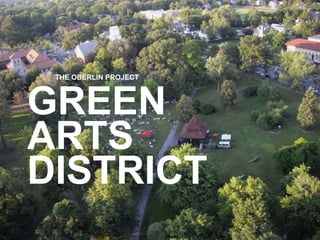Oberlin Green Arts District
- 3. GROWING A SUSTAINABLE SCIENCE + ART FUTURE
- 4. VISION VISION The Green Arts District will be a laboratory for exploring possibilities, promoting innovation in arts, music, sciences and sustainable design to reweave community, transform the way we learn and create new post-carbon economies.
- 5. FIVE PRINCIPLES POST-CARBON ECONOMY Embracing the challenges and great possibilities of the next century, we acknowledge the monumental task of transforming our local and global economy. The Green Arts District will provide an example of how, by living smartly, it is possible to improve the quality of our lives and heal our planet. COMMUNITY As a town and college we embrace the great opportunity and responsibility to renew our communal aspirations and strengthen our joint commitment to local and global communities. LEARNING Through transformative interactions among the arts, sciences, and the natural world we will initiate new ways of thinking, teaching, and learning. SUSTAINABILITY Leading through study and practice, we will embody sustainability through our actions, creating models that exhibit integrated solutions, amplifying environmental health, prosperity, and humanity. EXPLORATION Creativity, experimentation, and collaboration are ingredients for innovation and understanding. The Greens Arts District will demand exploration and reveal the human spirit.
- 6. WHY OBERLIN?
- 10. Oberlin Green Arts District – Oberlin, Ohio
- 12. SITE PLAN A Tappan Square B Allen Memorial Art Museum C Venturi Art Building Renovation and Expansion D Workshop E Hall Auditorium F Student Housing G The Center H Green Theater I Curricular Arts Building J Eco-machine K Forum L Lecture Hall M Restaurant N Oberlin Inn O Downtown P Black Box New Construction Renovation Existing
- 15. SITE CIRCULATION
- 17. HOW IT WORKS
- 18. Dockside Elephant & Castle Stockholm Royal Seaport Green Toronto Waterfront Lower Don Lands Albert Basin Magok Urban Treasure Island Development Project Redevelopment Project Oberlin Green Arts District Mahindra Destiny Florida World City Jaipur Godrej Garden City Panama Pacifo Victoria Harbour Pedra Branca Menlyn Maine Docklands, Sustainable Urbanism Melbourne Zonk’izizwe Town Center Vicurban@Officer Barangaroo
- 19. 02.14.12 04.24.12
- 23. Pedestrian Circulation Hall Gateway Building
- 24. Drop-off Access Hall Gateway Building
- 25. Loading & Trash
- 27. Water Collection 1 2 3 4
- 29. Geothermal Wells
- 31. Food
- 32. Integrated Systems Rain water collection • Reduce city water up to 80% • Irrigation for agriculture • Educational Component Eco Machine • Reduce city water up to 20% • Nutrients for agriculture • Irrigates green walls • Educational Component Agriculture • Irrigation from rain water • Nutrients from Eco Machine • Food for Oberlin Inn/Students • Educational component Heating / Cooling / Energy • Relies on ground temperature • Combined heating / power • Biomass stimulates economy • Educational component Rooftop Solar • Provides 50% GAD energy • Educational component
- 34. Categories HUMAN HEALTH ENERGY WATER FOOD ARCHITECTURE AND WELLNESS AND CONSTRUCTION LOCAL ECONOMY TRANSPORTATION NATURAL HABITAT WASTE OPERATIONS/ & ECOLOGY CONTINUOUS IMPROVEMENTS
- 35. Rating System Platinum Plus OPERATIONS / CONTINUOUS HUMAN HEALTH AND TRANSPORTATION NATURAL HABITAT & CONSTRUCTION LOCAL ECONOMY IMPROVEMENTS ARCHITECTURE & ECOLOGY WELLNESS ENERGY WASTE WATER FOOD LEED FOR MULTIPLE BUILDINGS AND CAMPUS BUILDING PROJECTS LEED FOR NEW CONSTRUCTION THE SUSTAINABLE SITES INITIATIVE (SITES) LEED FOR EXISTING BUILDING OPERATIONS AND MAINTENANCE GAD SUSTAINABILITY GUIDELINES
Editor's Notes
- #3: GAD is the heart of a city-wide strategy to transform Oberlin into the first post-carbon economy and create a sustainable model of a thriving community.
- #4: Incredible arts and sciences expertise Support for a broad initiative
- #7: Next şÝşÝߣ
- #8: Part of the global community
- #9: Example for struggling communities in the rust belt
- #10: Close connection between college and town
- #16: The Green Arts district will utilize cutting edge active and passive building technologies and site design strategies to incorporate natural systems into the built environment. By acknowledging the natural conditions, including hydrology and solar orientation, the Green Arts District maximizes natural day-lighting and achieves zero storm-water runoff. The eco-machine treats all the waste generated by the school and living buildings, and the landscape of the district works to harmoniously augment comfort and productivity. The minimization of energy use through building design, form and orientation will be coupled with energy production strategies such as photovoltaic panels, geothermal, biogas from site based waste, use of landfill gas or biomass for central heating and energy production, and the potential installation of a wind turbine for education purposes.
- #17: The site circulation is designed to both restore the historic promenade fronting on Tappan Square while also allowing maximum permeability into the District. A series of formal and organic connections within the site allow students, faculty, and visitors to mix where appropriate while also creating private spaces for College users. The ability of the district to act as a learning laboratory also encourages exploration of the buildings and the landscape to capture imagination and boost learning.
- #18: Our job to find the ways these systems can be integrated to maximize performance
- #19: The oberlin project is a city wide strategy to transform oberlin into a truly sustainable model of a thriving community. The green arts district is the heart of this initiative. other components of the project include a carbon neutral regionalenergy generation strategy, the creation ofa greenbelt and a corresponding resource management strategy and greening the arts, a program to understand how the arts can influence and communicate issues of sustainability to the larger world and also an analysis of the impact of current artspractices and materials.




































